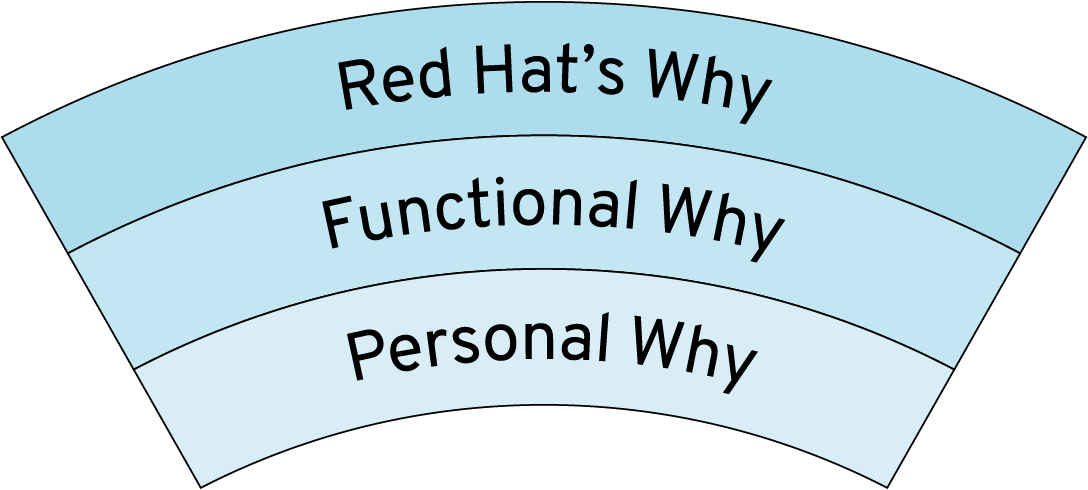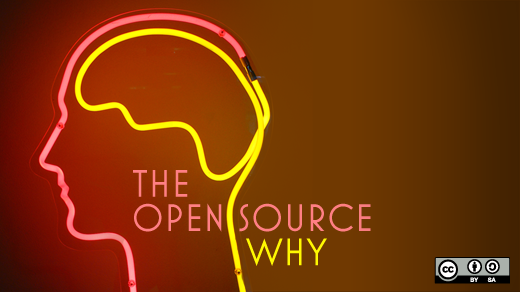One of the greatest challenges an organization faces as it grows is sustaining, evolving, and scaling the unique set of values and behaviors that differentiate its culture. In my previous column, I shared some research that we've done at Red Hat to tackle this challenge. Today, I'll share an update on our culture project: "Rediscovering Red Hat's Why," which we launched in March.
Rediscovering our why
Red Hat has long been a mission-driven organization, where people feel a strong sense of purpose and passion for using the power of open source to change the world. Over the years, we have taken the time to create a vision, values, and a competency model (among other cultural artifacts). Although Red Hat has an ethos rooted in the open source movement, we had never written down or articulated our company's special purpose (our "why") in any aligned way.
At times, Red Hatters have questioned whether various decisions are right for Red Hat. They hold leaders accountable not just for business success, but also for remaining true to our values, our identity, our reasons for existing. Without an aligned view on our purpose, we often have many different perspectives on what the "right" decision is. While differences of opinion are to be expected, as our company has been growing rapidly, that missing element was becoming more of a pain point and even a risk to our culture.
Last year, our CEO Jim Whitehurst challenged me to think about how we could scale our culture into the future. We decided it was important to invest time in articulating our purpose and our highest aspirations as a company. "Rediscovering Red Hat's Why" is a culture project that is helping us do that.
Purpose is everywhere
As we began to explore different ways of articulating purpose, we saw that many great organizations were doing similar work. That's because research suggests that companies with a clearly articulated purpose have more engaged employees and are twice as likely to deliver sustained high shareholder returns, among other benefits.
Most purpose discovery and articulation projects follow a similar path: Executives and senior leaders come together, share stories, and hammer out a "Why statement" or "Purpose statement" that is then promoted and reinforced throughout the organization.
We spent some very valuable time in conversation with thought leaders and experts in this area, including Simon Sinek and EY, and also reflected on the expectations for our organization that Red Hatters have. This led us to take an approach to our project that was different from other organizations—one that was true to our roots as an open source company.
We knew that Red Hatters would not feel connected to a Why statement handed down from our executive team. Although that process would be proven and simple to manage, it wouldn't be the open source way.
So we took an inclusive, open, and slightly chaotic bottoms-up approach to rediscovering our why.
An open approach
We began by inviting all Red Hatters—more than 10,000 people—to share their personal why stories by describing a moment when they felt especially proud to work at Red Hat. More than one out of every five did! These were some of the most incredible, inspiring stories I've ever read. Some Red Hatters even posted their stories to our company-wide mailing list and intranet, for all to read.
With more than 2,400 stories to process, a purely manual approach would have taken months. So we engaged our analytics team, who created a tool for identifying key narrative themes using open source natural language processing technology (you might recognize some of the open source tools we used, including R and RStudio on Fedora 25, with many R packages including Tidyverse, tm, SnowballC, koRpus, TreeTagger, and Topicmodels). Paring this tool with some human intelligence allowed us to identify the key themes from the stories.
Discovering our why themes
We identified seven common themes among the personal why stories submitted to the project, which I'll list here in no particular order:
- To advance open source as a force for good in the world
- To collaborate in extraordinary ways to turn ideas into a shared success*
- To care for each other like family
- To be an open organization where anyone can influence leaders and decisions
- To collaborate passionately with each other and our customers, partners, and communities to deliver great technical solutions to complex problems*
- To be part of an open organization gives me incredible opportunities to learn, grow, and make an impact*
- To take a stand for what we believe in when it counts, and our leaders have made a tangible difference in my life and career
(Items with an asterisk have a ". . . for our/my customers" focus to them for associates in customer-facing roles, such as those in Sales, Services, and Customer Experience & Engagement.)
The reason that the themes are not ranked in any particular order is that with our data model, on the whole, all seven contribute equally to Red Hat's why. As you look at different functional departments, you begin to see some of those themes bubble to the top.
Developing nested whys
Next, we encouraged each of our functional organizations (e.g. Marketing, Sales, and Services) to develop their own "Functional Why," a statement based on recurring themes in their people's personal why stories. Meanwhile, we began to develop a single, overarching Red Hat Why based on the personal why story themes, to articulate our company's shared purpose.
Ultimately, we set out to collaboratively create a series of "nested whys" so that Red Hatters could see the connection between their personal whys, the shared purpose of their functional organization, and to Red Hat's Why:

Courtesy of the Red Hat People Team CC BY-SA
For example, "To advance open source as a force for good in the world" was a top theme for our Legal team and our Products & Technologies group (which includes our engineering teams); whereas "To be an open organization where anyone can influence leaders and decisions" was more common among stories from our People and IT teams.
This phase of the project helped several organizations articulate their own Functional Why, which we're currently finalizing based on additional input from Red Hatters.
For an open organization, one of the most interesting aspects of these types of projects is identifying how to balance the bottoms-up, community-led approach with one that leverages the unique perspective of senior leaders, as well.
For this project, we worked with each member of our Corporate Leadership Team to determine how they wanted to approach developing their Functional Why statements. Several opted to convene their direct reports to develop a draft based on their associates' stories and key themes, and then surveyed their associates to further refine the statement. Some preferred to work alone to develop a draft based on the same information, and then circulated it for input.
On the People team, we've already crafted two iterations on our Functional Why, and we are in the process of finalizing the People Team Why. Our first hypothesis was: "We foster open leadership and community so Red Hatters can make a difference."
More than 50% of the team felt aligned to that statement, but one-third were unsure about it, and the remainder did not feel it expressed our shared purpose and highest aspirations. We made additional changes based on their feedback, and 78% of the team felt aligned to the second draft.
Pending some final tweaks based on round two of feedback, our People Team Why is shaping up to be something akin to: "Through collaboration and caring, we enable Red Hatters to be open leaders who make a difference for our customers and communities."
Drafting Red Hat's Why
Next, we will be bringing the Corporate Leadership Team together with a global, cross-functional advisory team of 20+ Red Hatters to develop a rough draft of the Red Hat Why statement based on the seven themes and the functional whys, which we'll share with the entire company (all 10,000+ associates) for feedback in October.
From there, we'll finalize the Red Hat Why and begin to use it in a multitude of ways (that's a topic for another column!), including making business decisions, as I mentioned earlier.
The big lesson I've learned so far is that it's important to pay attention to our instincts about what will work best in our open organization's culture. Taking an open and inclusive approach has been a heavy lift, and to add to that, we set an audacious goal of completing the first draft of the Red Hat Why by October, as part of our We Are Red Hat Week celebration. That's required our leaders and project team to manage a lot of tension as we move this project forward. Yet as we finish up phase one of Rediscovering Red Hat's Why, I can see that it was the right way to engage, and we've seen a high level of passion and energy from associates on this project.
I look forward to sharing the final version and additional lessons learned, and I'd love to hear what your organization is doing to discover and articulate your unique purpose, as well! Please share your stories in the comments.






1 Comment